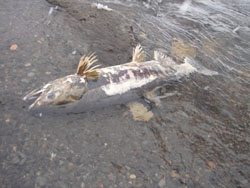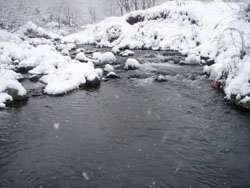The swimming dead
By Mark Brazil | Dec 20, 2006
SALMON'S ULTIMATE SACRIFICEThe midwinter solstice is here again, and our nights have reached their longest and our days their shortest, driven by our planet’s sun-centered rotation and the tipping of our orbiting Earth.
In the endless cycling of the seasons, it’s a time of year that has engendered innumerable beliefs and superstitions, from the Roman festival of Saturnalia, to the mythology surrounding mistletoe and the birth of Christ; from ghosts, ghouls and spirits, to jolly, red-and-white-clad Santa Claus in his reindeer sleigh.
In the natural world, however, this longest night represents a tipping point; from thereon the days lengthen toward spring, toward renewal and growth (symbolized for many in the holly bough or Christmas tree).
But before the rebirth of a new year is possible, sacrifice and suffering accompanying the passing of the old year is necessary — and for some species that terminal rite is taking place even now. I watched this “sacrificial” process recently, during what I can only refer to as “the night of the swimming dead.” No, there weren’t zombies in facemasks and flippers, nor anything else from horror films. It was an event drawing to a close right now in some major northern rivers — the running of the salmon.
Just last week, I had dozed fitfully through the night on a futon in a rustic minshuku (guest house) on the Shiretoko Peninsula in northern Hokkaido. My muscles and joints were aching thanks to a debilitating virus, and my blocked nose and sinuses were being chilled by the subzero temperature in the room. Then, through my fever, I heard a loud clattering on the roof. Childhood imaginings of a rotund Santa and his team of trotting reindeer were quickly dispelled as a deep, hollow, double note was answered by a third reverberating call just outside. A repeat of that sonorous triple-noted duet confirmed the presence of a pair of Blakiston’s fish owls calling just above my head, on the roof.
When I woke again it was morning, and the owls had retreated, spiritlike, back into the forest. There was yet more snow, and though it was tempting to remain in the cocoon of my warm futon, I needed fresh air. I also wanted to confirm whether the macabre creatures I remembered seeing in the river the evening before were really there, or just part of my febrile imaginings. So I stumbled down to the stream just outside, where I had spent several hours the previous evening in silent contemplation of the annual miracle of death and rebirth.
Pallid rotting corpses
In the darkness of that evening, I had listened intently as the running, rushing and gurgling of the stream was broken by brief, but more deliberate splashing.
In darkness, I had glimpsed the shadowy pale perpetrators of those splashes, but now, by daylight, I was witness to the last great sacrifice of the season. The shallow stream bed was littered with pallid rotting corpses, the “ghosts” of sleek marine lives past. Here and there, corpselike, but not yet dead, were animated, partly skeletal fish — the “swimming dead.” Their powerful instincts to return “home” where they had hatched years before, and to breed, had overtaxed their physical resources. Now their bodies were in decline, literally wearing away, breaking apart, as they battered themselves against the stones protruding from the stream.
In the evening I had glimpsed pale, scaleless flanks and torn fins, but now, up close, I found individuals that had worn their pectoral fins to the bone, whose dorsal fins protruded not as sleek, silvery blades, but as ragged skeletal fans. The evening before I had watched one ugly apparition fight again and again to climb upstream, only to be overwhelmed by the water’s flow and be battered back downstream by the current and cast up on exposed rocks. As I watched it expire, I could only admire the power of the instinctive drive to achieve its genetically encoded goal, and ponder whether we humans, overburdened with our sense of self, are not somehow more hampered from achieving life’s fulfillment.
As I searched for that individual again by daylight, an apparent fish corpse lying at my feet startled me by suddenly bursting back to life. Its great tail thrashed, sending gouts of water splashing upward, its head rose up monstrously from the stream’s flow, as it gulped and gasped. A last nervous impulse, triggered perhaps by my shadow falling across its eye, had sparked this final burst of energy from almost entirely spent muscle.
As I stood in the stream surrounded by the dead and dying remains of once-great salmon, returned from their lives at sea, it would have been easy to become maudlin — even to be depressed by the apparent futility of life’s struggle — but instead, I saw symbols of life to come, of rebirth.
These anadromous fish, born in freshwater but adapted to living their lives in saltwater at sea, had braved a great physiological transformation to return to the river of their birth. Here they fought: the females to scrape out a redd, a shallow depression in the gravel stream bed undisturbed by other females, the males to repel other males and gather females to them, to possess them in a miniharem. The female lies on her side to release her reddish-orange eggs, like precious pearls, into the gravel, while the possessive male ejaculates his milt over the eggs to fertilize them before the female sweeps gravel over them with her tail. Over and over again this pattern of fighting and fecundity is repeated until the female has exhausted her flesh while laying several thousand eggs, and the battered and bruised male has no more fight left in him.
As the year comes to a close, the last of the running salmon thrash their way upstream. On the Shiretoko Peninsula, earlier, autumn-spawning fish are savored by brown bears before they hibernate; more widely in eastern Hokkaido, later-running fish are still present in rivers when the marvelous Steller’s eagles arrive in early winter. Then, river mouths attract fascinating congregations of eagles, gulls and crows.
Nature’s endless recycling
Yet even further south, in Honshu and Kyushu, where there are neither bears nor eagles to take advantage of the bounty of dying fish, their flesh is not wasted. The remains of the adult fish sink to the riverbed and, in the cold autumnal and winter water, as their bodies break down slowly, their nutrients are released back into the freshwater ecosystem, providing food for riverine invertebrates.
As part of nature’s endless recycling system, the salmon’s pearly eggs hatch into a new generation of tiny fingerling parr that will make the river their home, feeding off the invertebrates that may have themselves benefited from the nutrient “fertilizing” of adult salmon bodies.
Then, one to three years later, as smolt salmon, they make their way to the sea where they live off the riches of the ocean for several more years while growing into large, magnificent specimens. Throughout each autumn and on into winter, the returning hordes of mature salmon gather in spectacular shoals just offshore, awaiting the amazing physiological shift that sees them switch back to freshwater after living in saltwater.
Their arrival upstream heralds an enormous bounty of energy carried back from the sea; they deposit it, in the form of their bodies, in their natal rivers, and so, as part of the ceaseless cycle of the year and of life, they contribute their own living matter to the freshwater ecosystem, fueling it with their own energy for the next generation to thrive on.


